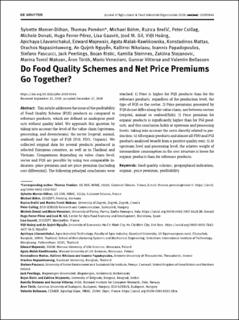Do Food Quality Schemes and Net Price Premiums Go Together?
Monier-Dilhan, Sylvette; Poméon, T; Böhm, Michael; Brečić, Ruzica; Csillag, Peter; Donati, Michele; Ferrer-Perez, Hugo; Gauvrit, Lisa; Gil, Jose M.; Hoang, Viet; Lilavanichakul, Apichaya; Majewski, Edward; Malak-Rawlikowska, Agata; Mattas, Konstadinos; Napasintuwong, Orachos; Nguyen, An; Nikolaou, Kallirroi; Papadopoulos, I; Pascucci, S; Peerlings, Jack; Ristic, Bojan; Steinnes, Kamilla Knutsen; Stojanovic, Z; Tomic Maksan, Marina; Török, Áron; Veneziani, Mario; Vittersø, Gunnar; Bellassen, Valentin
Peer reviewed, Journal article
Published version
Permanent lenke
https://hdl.handle.net/11250/2774073Utgivelsesdato
2020-12-03Metadata
Vis full innførselSamlinger
Originalversjon
https://doi.org/10.1515/jafio-2019-0044Sammendrag
This article addresses the issue of the profitability of Food Quality Scheme (FQS) products as compared to
reference products, which are defined as analogous products without quality label. We approach this question by taking into account the level of the value chain (upstream, processing, and downstream), the sector (vegetal, animal, seafood) and the type of FQS (PGI, PDO, Organic). We collected original data for several products produced in selected European countries, as well as in Thailand and Vietnam. Comparisons depending on value chain level, sector and FQS are possible by using two comparable indicators: price premium and net price premium (including cost differential). The following principal conclusions were reached: 1) Price is higher for FQS products than for the reference products, regardless of the production level, the type of FQS or the sector; 2) Price premiums generated by FQS do not differ along the value chain, nor between sectors (vegetal, animal or seafood/fish); 3) Price premium for organic products is significantly higher than for PGI products, and this conclusion holds at upstream and processing levels, taking into account the costs directly related to production; 4) All organic products and almost all PDO and PGI products analysed benefit from a positive quality rent; 5) Atupstream level and processing level, the relative weight of intermediate consumption in the cost structure is lower for organic products than for reference products.
